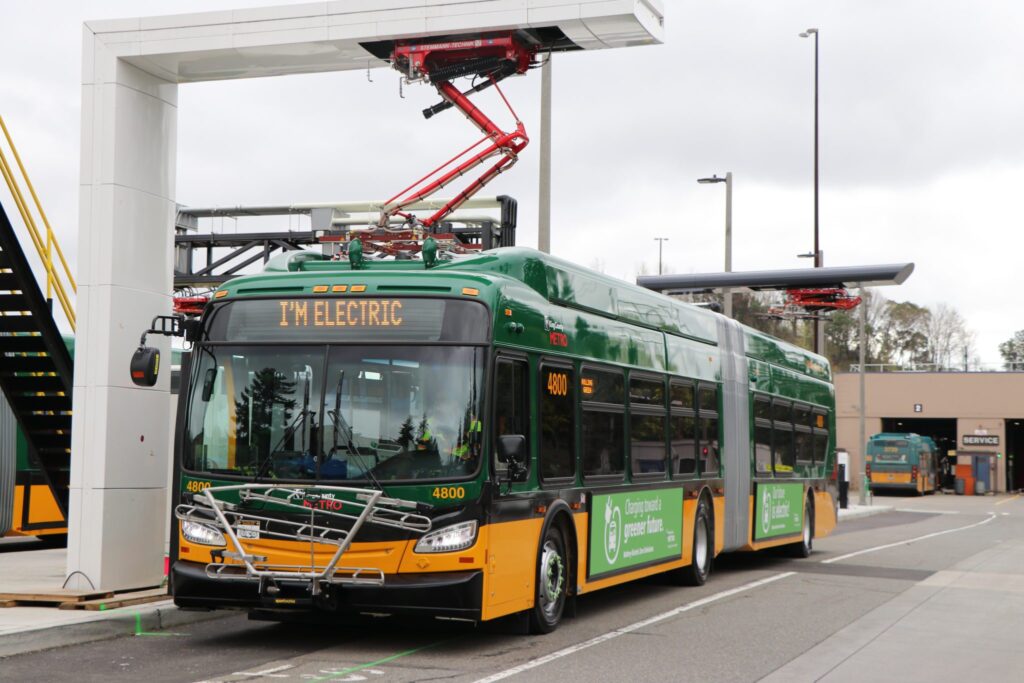Transportation is the primary contributor to greenhouse gas emissions driving climate change in Seattle. Pollution from transportation degrades air and water quality, all of which disproportionately harm our Black, Indigenous, and people of color communities. Seattle City Light is committed to reducing climate pollution in the transportation sector. To accomplish this, we’ve been working with other City departments to achieve ambitious goals by 2030.

In March 2021, the City of Seattle released a first of its kind, comprehensive Transportation Electrification Blueprint. This document outlines how the City will move toward a clean and equitable transportation system to reduce climate emissions and air pollution, increase electric mobility options, and create a pipeline of green jobs and workforce diversity. City Light was proud to co-lead this effort with the Office of Sustainability and Environment, Seattle Department of Transportation (SDOT), and the Office of Economic Development to incorporate a wide range of expertise in climate policy, innovation, infrastructure, transit, mobility, economic development, and workforce development to ensure an equitable transition.
The development of the Transportation Electrification Blueprint included consulting with community leaders and the Environmental Justice Committee. It is centered on community-identified priorities of expanding electric transit and mobility options, making electric vehicles and charging more accessible and reliable, and connecting workforce opportunities to communities who need them the most.
The Transportation Electrification Blueprint calls for the City of Seattle to take immediate action to plan for the policy changes, infrastructure investments, and partnerships that will be required to meet the following ambitious 2030 “North Star” goals for the City:
1. 100 Percent of Shared Mobility is Zero Emissions
As shared mobility services like bikes, scooters, taxis, Uber, Lyft, carshare services and others continue to expand in Seattle, the City will ensure these options are electric and emissions free. For example, this year City Light and SDOT supported efforts to get the first electric ADA carshare van in Washington state up and running.
2. 90 Percent of All Personal Trips are Zero Emissions
To reach our climate goals, by 2030 nine out of ten trips must be taken by walking, biking, electric transit or in an electric vehicle (or avoided all together). To support this goal, we have started installing Level 2 curbside EV chargers from our pilot project.
3. 30 Percent of Goods Delivery is Zero Emissions
As more and more of the goods we buy and the food we eat are purchased online, we are seeing growing congestion and pollution from transportation. This goal is aimed to spur the transition of private fleets to EVs, following the same goal for personal vehicles, over the next 10 years. We have taken steps to develop a new program to help small businesses transition their fleets to EVs.
4. 100 Percent of City Fleet is Fossil-Fuel Free (Executive Order 2018-02)
Continuing to lead by example, Seattle will operate a large municipal fleet with zero fossil fuels by 2030. At City Light, we have launched fleet and personal mobility programs in support of this goal.
5. One or More “Green & Healthy Streets” in Seattle
Seattle will ensure a major area of our city will have zero emissions from transportation, including streets or blocks that are closed to cars and promote walking, biking, electrified transit, and electric goods delivery and services.
6. Electrical Infrastructure Required to Stay Ahead of Transportation Electrification Adoption is Installed and Operational
Infrastructure investments will enable a rapid transition to an electrified transportation system. We’re working strategically to make sure the grid is reliable and built out to enable rapid adoption for emerging electric-transportation technologies and vehicles.
City Light is proud to be part of the strides the City of Seattle has made toward reaching these goals in the last two years. The following report highlights past and current cross-departmental work to propel Seattle toward our 2030 North Star goals.
Together, we are planning our next phase of action in 2023 and 2024. In sharing our progress, we hope to provide a transparent illustration of the projects that are helping the City achieve its clean transportation electrification goals.